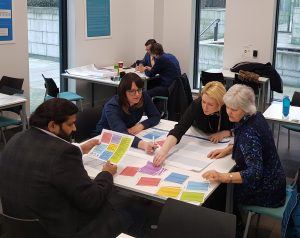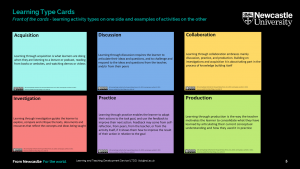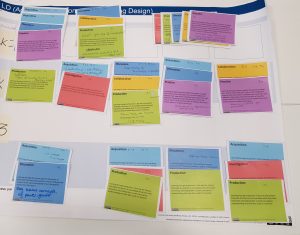Leadership Development & Organisation Futures Team (LDOF)
Newcastle University Business School
Faculty of Humanities and Social Sciences
Who was involved?
Leadership Development and Organisation Futures (LDOF) Team: Dr Joanne James (Director), Dr Nicola Patterson (DPD Strategic Leadership MSc), Dr Amy Stabler (DPD Coaching & Mentoring MSc), Dr Jenny Davison (DPD Executive MBA), Dr Sandra Corlett (Senior Lecturer in Leader Dev & Org Futures)
Michelle Barr: Design and Development Project Lead (LTDS)
NUBS colleagues teaching on the programmes.
Why we used the ABC method to design the Executive Education Postgraduate Programmes
We wanted to use a curriculum design method that enabled us to work collaboratively and holistically at a cross-programme design level. We also wanted a method that provided the teaching teams with the opportunity to engage in curriculum and assessment conversations. Creating learner-centred programmes is a core aspect of our pedagogy, so adopting a method that keeps the learner at the heart of the design phase was also essential.
By adopting the ABC Learning Design Method, the teaching teams were able to work collaboratively using a hands-on storyboarding approach. Through a series of facilitated sessions, we were able to create a rich mix of blended learning activities and engage in holistic and reflective design conversations.
In this short video, Dr Nicola Patterson (DPD Strategic Leadership MSc) tells us why she thinks the ABC method was right for the Executive Education Programmes.
What is ABC Learning Design?
Arena Blended Curriculum (ABC) is a learning design methodology underpinned by Prof Diana Laurillard’s 6 learning types which run as a high-energy, hands-on curriculum design workshop. This practice can be adapted for entire course design, module planning or developing engaging teaching sessions.
What is involved in an ABC Learning Design Workshop?
Tweeting your module
At the beginning of the workshop, programme teams are asked to write a tweet size description of their module.
Nicola tells us why this part of the session was challenging but beneficial in terms of getting the essence of the module condensed into a snappy description that learners could easily understand.
Example of one of the module-info and graph sheets from one of the LDOF workshops
The Learning Types
One of the real values of the ABC method is going through that process of thinking about the learning design in terms of the different types of learning activities the learners will engage in. This is one of the key reasons why the ABC method is a learner-centred approach.
Nicola tells us why pushing the boundaries of the learning types supports learners to engage with the learning content but also helps learners to apply this to real-world scenarios or their work-based context.
Module Learning Types with descriptions.
The Storyboard
The storyboarding activities not only helped us to design the right blend of learning activities and the right mode of delivery, but they also became the foundation for managing the curriculum design and development process as we moved through the phases of the project. We were able to identify what digital content needed to be created and translate the final iterations of the module designs to our Canvas VLE.
Nicola shares with us the impact of the storyboarding activities and how it stretched their thinking and helped them to be more creative.
Storyboard image from one of our sessions.
Contacts
 Michelle Barr, Learning Enhancement & Technology Project Adviser.
Michelle Barr, Learning Enhancement & Technology Project Adviser.





